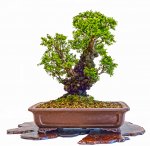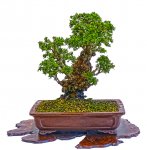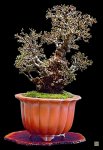fredtruck
Omono
As I’ve become more familiar with my Yatsubusa, I noticed that the bark seemed to be covered with a layer of soft mushy sediment. I suspected that as the tree grew, it shed small particles of bark, and that’s what this sediment was. I was determined to clean the tree. I tried the toothbrush/scrubbing method, and had some success, but not enough. Then I read about Bill Valavanis’ use of a pressure washer to clean his trees. One of them he cleaned was his Seiju elm, which is very similar to my tree. I did my own searching, but found nothing that I thought would work, so I wrote Bill and asked him. He said he used a pressure washer made just for bonsai that he got from Japan. But since it cost $600, he suggested I try the Arrow Spot Cleaning gun carried by Amazon, for $65. I checked it out, ordered it and sprung for expedited shipping, since my “gotta-have-it-now” button was in play.
I had also read a number of things by B’nut users about using these guns. So when my Arrow arrived, I dialed the pressure way down, and stood back from my tree. I thought the results were amazing!
I was surprised to find that when the Yatsubusa dried thoroughly, the bark was quite hard. I expected the sediment to be gone, but I thought the remaining bark would be on the soft side. Not so. It was very firm, tough even.
Below, I’ve posted 2 pictures. The first picture is “before,” and the second is “after.”


I had also read a number of things by B’nut users about using these guns. So when my Arrow arrived, I dialed the pressure way down, and stood back from my tree. I thought the results were amazing!
I was surprised to find that when the Yatsubusa dried thoroughly, the bark was quite hard. I expected the sediment to be gone, but I thought the remaining bark would be on the soft side. Not so. It was very firm, tough even.
Below, I’ve posted 2 pictures. The first picture is “before,” and the second is “after.”








